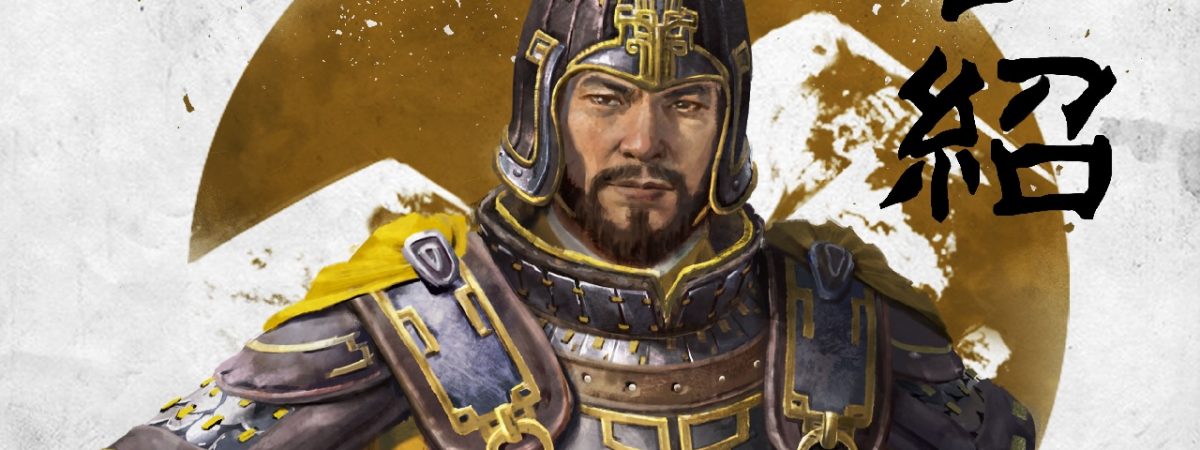And your macro sucks too
Last month, I wrote a post about micro mistakes, and this time I will talk about macro, or macromanagement. In particular, I will talk about 5 macro mistakes and their corresponding real-life examples. Contrary to the last time, when I used Age of Empire to illustrate, I will use Warcraft III in this post.
As I said in the last post, I have been a big fan of RTS games since a little child but have never been good at it. Not only my micro sucks, but also my macro sucks even more. In RTS games, macro, or macromanagement, refers to a player’s management of economic expansion and large-scale strategic maneuvering. It is a pivotal but often overlooked game factor.
Recently I revisited some classic and popular RTS games such as Age of Empires and Warcraft III, and I obtained an understanding of why I sucked in these games and how I sucked. In the last post, I used Age of Empires to illustrate common micro mistakes, and in this post, I will use Warcraft III to illustrate common macro mistakes. Many of the understandings in this post are thanks to Grubby, a six-time world champion and one of the best Orc players.
In particular, I will depict 5 macro mistakes and relate them to real-life management mistakes.
- Put more than five workers on your gold mine
- Not always produce units
- Actions do not match the strategy
- Death march
- Not play the units the way they want to be played
Put more than five workers on your gold mine
Once you start the game, you are immediately provided with a town hall, five workers, and a gold mine, all sitting near a forest. Gold and lumber are the two resources in Warcraft III, so you immediately face the decision of how many workers you want to allocate to each resource.

One common mistake is to think that the more workers you put on the gold mine, the more gold you will get per minute. Alas, the developer, Blizzard, developed this game in such a way that a maximum of five workers can simultaneously work on a single gold mine, regardless of race.
Night Elves can put at most five wisps in their entangled gold mine.
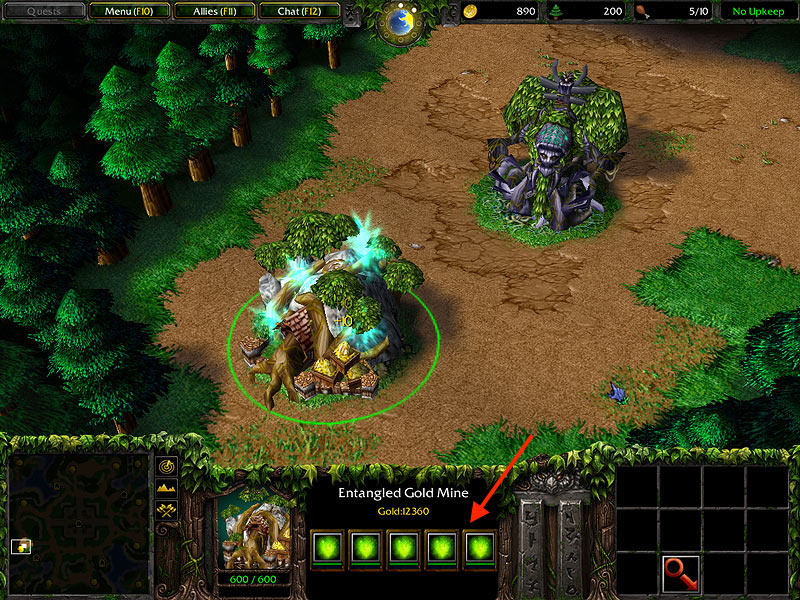
The Undead’s haunted gold mine has only five slots for their acolytes.
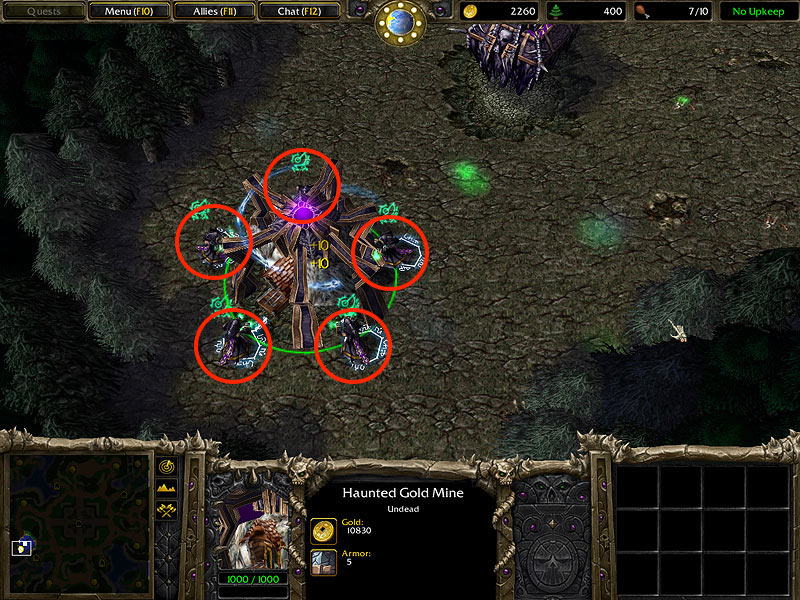
While Night Elves and the Undead present a visual cap of the maximum number of workers, Humans and Orcs can be visually deceiving. The workers of the latter obtain gold by carrying it back to the town hall, which misleads you to think that the more workers you use, the more gold you will obtain per minute.
The tricky part is that the workers need to enter the gold mine to obtain gold and that the gold mine can contain at most one worker at a time. The moment the 5th worker comes out of the gold mine (with a sack of gold on his shoulder), the 1st worker is ready to enter the gold mine after having returned the gold to the town hall.
A 6th worker will have to wait outside and never gets a chance to get in unless you build the town hall farther than the shortest distance allowed from the gold mine. The shortest distance is determined in such a way that you only need five workers, and they produce 10 gold per second, on par with the other races. You can build your town hall farther away and use more workers, but you still get 10 gold per second at most.

Real-life example 1
In the game, there is no punishment for putting extra workers on the gold mine. The worst you get is an idle worker. In reality, the outcome can be worse: an extra worker can significantly decrease the overall productivity.
The Chinese fable of Three Monks is a classic and popular example. A young monk lives a simple life on a hilltop Buddhist temple. He has one daily task of hauling two buckets of water up the hill using a carrying pole.
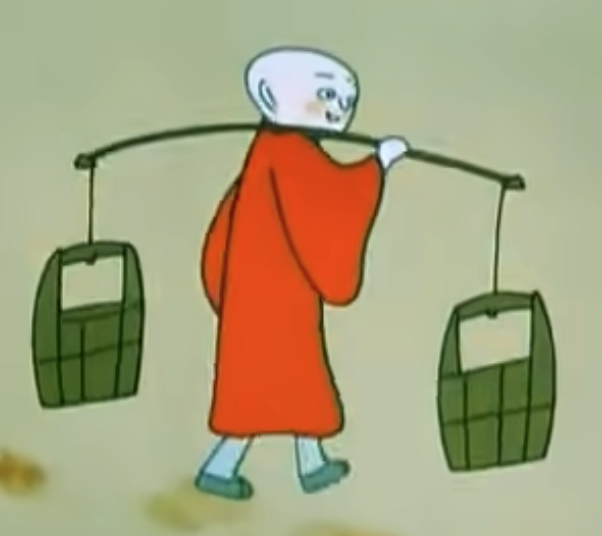
When a skinny monk joins him, they can only haul one bucket at a time because of the nature of the carry pole. The number of workers doubles, but the yield halves.
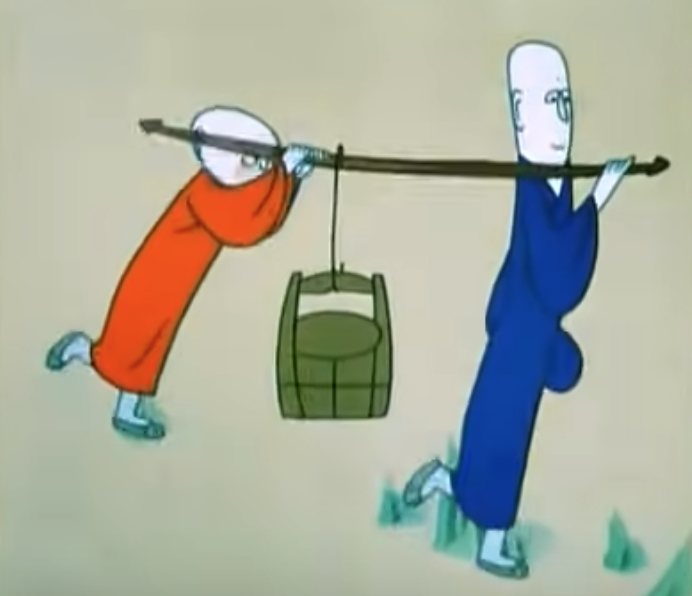
When a third fat monk joins them, none of them are willing to take the task.
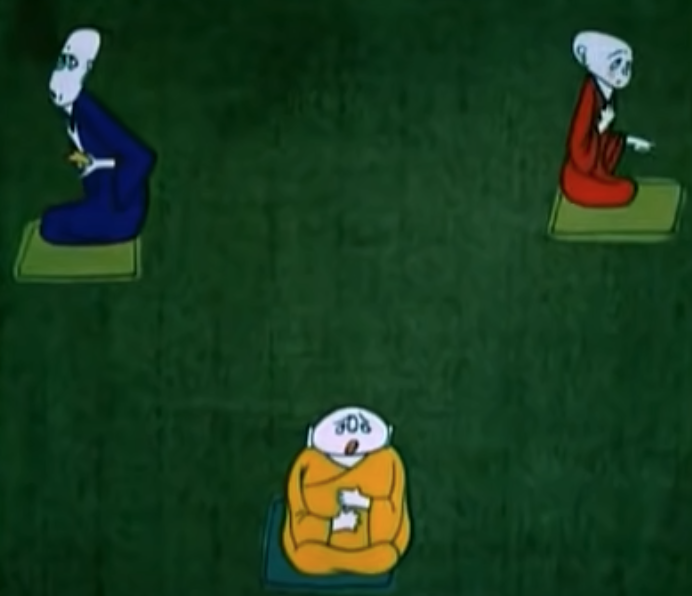
This fable may sound childish, stupid, and even unreal, but I have a real-life experience mirroring this situation. I once lived with a girl in a three-bedroom flat, and we shared the cleaning task until a third boy moved in. That boy was outside picking up girls all day long and treated the flat as a hotel. He dirtied the flat, and consequently neither I nor the girl was willing to do the cleaning.
Similar stories have happened on a much larger scale in USSR and China. The collective farms thereof ruined the economy.
Not always produce units
Another common mistake and one I often commit is forgetting to produce units constantly. Usually, I produce several units and send them to creep or harass the enemy, totally forgetting to build new buildings, research new technologies, and train new units.
I left the base idle except for the several workers collecting a lot of gold and lumber. In other words, I did not transform the resources into military or technological advantages. I may kill some creeps and even win a skirmish, but the opponent always comes back with a much stronger army.
Beginners often commit this mistake, as is shown in Grubby’s guide or crash course (see below). The losing newbie opponent asked Grubby for tips. Grubby, with a kind and nice nature, told him to “make units at a constant rate.”
Real-life example 2
The real-life counterpart is logistics, which many managers overlook. In the Korean War, the Chinese army PLA hastily joined the war during the winter. 1,450,000 soldiers had only 400,000 pieces of winter clothes. Many soldiers died from low temperatures.

Actions do not match the strategy
The above two mistakes are easy to spot, but the one I am now going to talk about is insidious. Some players build buildings, train units, and research technologies as normal, but they always lose. I call their play style cargo-cult management: They seem to be managing, but their actions do not match their strategy, or they do not even have a winning strategy.
It is a bit dry to talk about abstract concepts; let’s watch the following video clip, where Grubby analyzed a fan’s game replay.
In the clip, Grubby explained that the player in question could have upgraded the base at 2:15 rather than at 3:40 as the player actually did. This delay was due to an unused Voodoo Lounge (shop), and it resulted in a delayed second hero, Tauren Chieftain, and advanced units.

Grubby made this judgment because he reasoned that the player intended to do a single-hero early harassment (judging from his build order), and the goal of this strategy is to reach tier 2 quickly and then use an early second hero along with advanced units to crush the unready enemy. The building of the Voodoo Lounge did not contribute to this goal.
In the replay, the player could have had more than six headhunters (a basic unit) because of the tech delay. This early military advantage could have helped him to creep more, yet he only produced two headhunters, with all the extra gold unused.

The player’s actions seem to mix two strategies together. In consequence, he got none of the benefits and got the disadvantages of both. Sometimes it is described as the misalignment of actions and strategy. More often than not, the player does not have a strategy, to begin with.
If a player can win by this, it must be pure luck.
Real-life example 3
Donald Trump best demonstrated this mistake. His policies were a mix of many isolated actions without a coherent strategy behind them.
Death march
In the same clip as above, the player got complacent after a skirmish win and jumped into the opponent’s base with an unprepared army. The opponent played the Undead, whose base, according to Grubby, was nothing other than a death trap.
The Undead has fast regeneration on the blight; the undead’s defense towers have a slowing effect; the graveyard can produce corpses, which are fodder for summoning skeletons and beetles; the lumber-collecting ghouls can all become battle units. As a result, the player lost almost every unit but killed nothing.
Real-life example 4
Many managers commit this mistake. They are proud of themselves, but in fact, they have no foresight of the future. They lead their team, gradually but eventually, to failure. This is called the death march.
Not play the units the way they want to be played
In the same clip, Grubby also pointed out the player’s underuse of Witch Doctor. The player produced Witch Doctors but used them more like an average unit.

Witch Doctors have three abilities: Sentry Ward, Stasis Trap Ward, and Healing Ward. With these abilities, the player could have contained the opponent in his base and eliminated all creeps in the surrounding, according to Grubby.
Real-life examples 5
In real life, some managers are very charismatic, and they attract many talents around them. Nonetheless, the charismatic manager never takes any advice from them, nor does he give any authority to them. Instead, he always listens to those good at flattery. Those treacherous people get power, and the talents get marginalized. Yuan Shao in the late Eastern Han Dynasty is an example.
